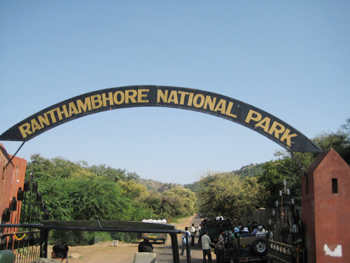Ranthambore National Park

Situated in Eastern Rajasthan, where the Aravali Hill ranges and the Vindhyan plateau meet, the Ranthambhore National Park was once the hunting preserve of the Maharajas of Jaipur. The rivers Chambal in the South and Banas in the North bound the Ranthambore National Park.
Six man-made lakes are the central focus of the park and many perennial streams criss-cross the entire park. The Ranthambore National Park has internal drainage and has no link up with any river system, even though two rivers bound the Park in its north and south side.
Flora in Ranthambore National Park
The landscape is dotted with ancient Banyan Trees, Dhok & Pipal trees, clusters of mango trees and crisscrossed with evergreen belts. The terrain is made up of massive rock formations, steep scarps, perennial lakes and streams, and forest suddenly opening up into large areas of Savannah. The terrain of Ranthambore Wildlife Sanctuary fluctuates between impregnable forests and open bushland. The forest is the typically dry deciduous type, with Dhok, being the most prominent tree.
Major Wildlife Attractions – Ranthambore National Park
Ranthambore National Park is famous for its Tigers and is a favorite with photographers. For a relatively small area, the park has a rich diversity of fauna and flora – species list includes 300 trees, 50 aquatic plants, 272 birds, 12 reptiles including the Marsh Crocodile & amphibians and 30 mammals.
For the wildlife savvy, Ranthambore wildlife sanctuary today offers an intense diversity of flora and fauna. Tigers, the park’s pride makes it one of the best places in the country to observe them. Apart from that a large number of Sambar, Chital, Nilgai, Gazelle, Boars, Mongoose, Indian Hare, Monitor Lizards, and a large number of birds.
Other Attractions In Ranthambore
Ranthambore Fort & Jogi Mahal :
With a coverage area of 392-sq-km, this park got its name from the Ranthambhore Fort, which sits on a rocky outcrop in the heart of the Park. The fort, which dates back to the 10th century and is probably the oldest existing fort in Rajasthan, was a vital citadel for control of Central India and particularly the Malwa plateau.
The entry point to the Ranthambore National Park goes straight to the foot of the fort and the forest rest house, Jogi Mahal. The latter boasts of the second-largest Banyan tree in India.
Best Time to Visit Ranthambore
The best visiting season of Ranthambore national park is during the months of October – March, and April to June.
How to Get there
Air: Jaipur at 145-km is the nearest airport from Ranthambore wildlife sanctuary. Rail: Ranthambore National Park is around 11-km away from Sawai Madhopur railway station, which lies on the Delhi to Bombay trunk route. Road: A good network of buses connect Sawai Madhopur, the nearest town from Ranthambore to all the major cities within the state of Rajasthan.Park Visitation Timings
- Between October To March: 6.00 am – 9.00 am & 3.00 pm – 6.00 pm
- Between April To June: 6.30 am – to 9.30 am & 3.30 pm – 6.00 pm
General Info / Tips
Note: Light cotton garments are recommended to visitors while visiting Ranthambore national park during the hot summer months and woolens are suitable for the winters. Entry charges for a hired vehicle, guide, and photo equipment are separate. These can be reserved at the Project Tiger office in Sawai Madhopur.
